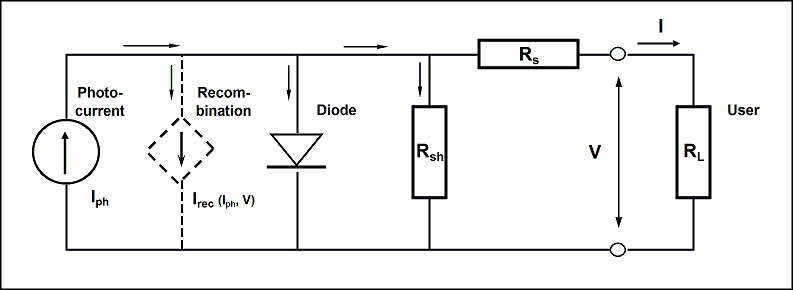|
<< Click to Display Table of Contents >> Thin film modules: Recombination losses |
  
|
|
<< Click to Display Table of Contents >> Thin film modules: Recombination losses |
  
|
When it fits well the behaviour of Vco in Crystalline and CIS modules, the standard model fails to reproduce the amorphous modules voltage in any irradiance and temperature conditions.
Amorphous junctions differ from other junctions by the presence of an "intrinsic" layer (p-i-n junction). J. Mertens 1 al. propose to take the recombination losses in this I layer into account, by adding a term in the general I/V equation. This term is equivalent to adding an element to the equivalent circuit, representing a current leak depending on the photocurrent and the voltage.

Modelling of this phenomenon leads, under some hypotheses, to the following expression for the recombination current:
Irec = Iph · di² / [ μτeff · (Vbi - (V + I Rs)) ]
where di = Thickness of the intrinsic i-layer (of the order of 0.3 μm),
μτeff = Diffusion length of the charge carriers p and n:
μτeff = 2 · μn τn · μp τp / (μn τn + μp τp)
| Vbi = | Intrinsic voltage ("built-in voltage) of the junction. Its value may be considered as constant, and is about 0.9V for an amorphous junction. |
With this new term the general one-diode model I/V expression becomes
I = Iph - Iph · di² / μτeff · 1 / (Vbi - (V + I Rs))
- Io [ exp (q · (V+I·Rs) / ( Ncs·Gamma·k·Tc) ) - 1 ] - (V + I·Rs) / Rsh
In our phenomenological study of 4 amorphous modules, we considered the quantity di² / μτeff as one only parameter, and we sought the value which optimized the Vco response of the model. For all our modules we found that a value (di² / μτeff) around 1.4 V gives excellent results and corrects quite well the Vco distribution, with a simultaneous improvement of the Pmax response.
For example on our SHR-17 tripple-junction, the RMSE on Vco drops from 3.3% to 0.7%, and the MBE from 4% to 0.2% with this correction. Simultaneously, the RMSE on Pmax is improved from 5.8% to 4.1%.
It should be noted that this new term doesn't modify significantly the procedure used for getting the model parameters. Simply the photocurrent value is now affected by a voltage-dependent correction in the equations. Nevertheless the resolution of the model gives a quite different gamma value, compatible with its "physical" limits.
Back to Standard "One-diode" model.
Back to Amorphous and Thin films modules.